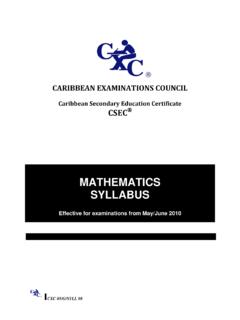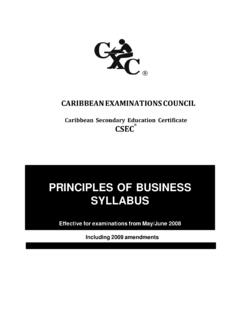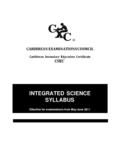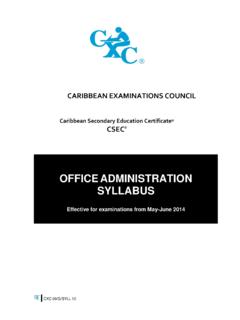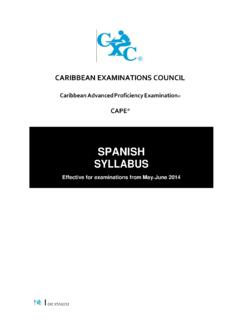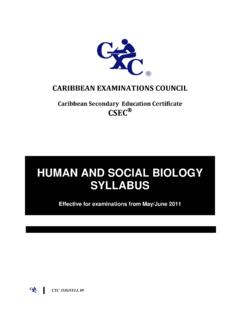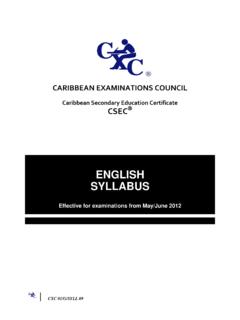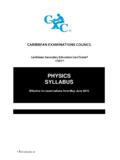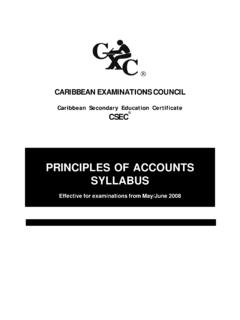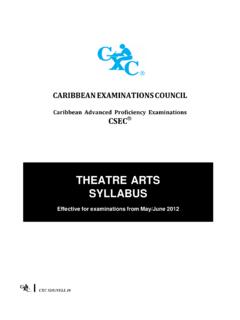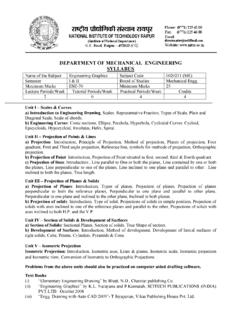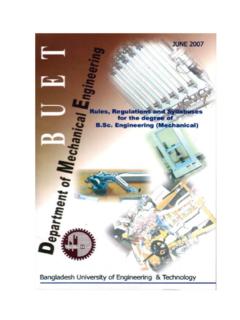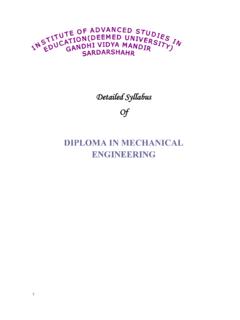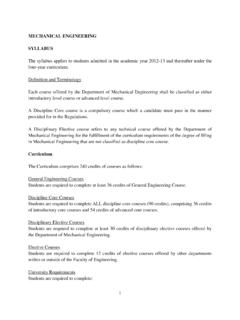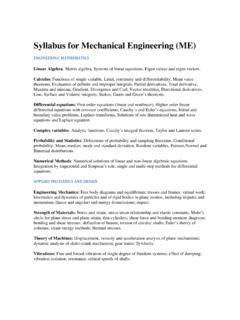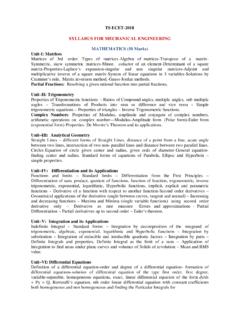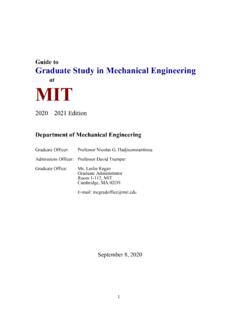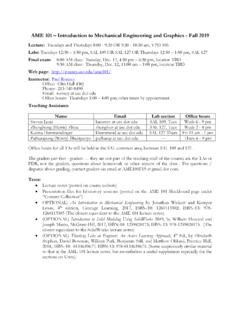Transcription of INDUSTRIAL TECHNOLOGY PROGRAMME - CXC | …
1 CARIBBEAN EXAMINATIONS COUNCIL Secondary Education Certificate Examinations Attention is drawn to amendment placed after page 134 Correspondence related to the syllabus should be addressed to: The Pro-Registrar Caribbean Examinations Council Caenwood Centre 37 Arnold Road, Kingston 5, Jamaica Telegraphic Address: CAXCO JAMAICA Telephone: (876) 928-2513, 922-9121 Facsimile Number: (876) 967-4972 E- mail address: Copyright 2000 by Caribbean Examinations Council The Garrison, St Michael 20, Barbados INDUSTRIAL TECHNOLOGY SyllabusesEffective for Examinations from May/June 2002 CXC /13/T/SYLL 00 AMENDMENTS The former INDUSTRIAL Arts (Electricity/Electronics, Woods, Metals) and INDUSTRIAL TECHNOLOGY (Electrical, Building, mechanical engineering ) syllabuses were revised in 2000 and incorporated in one volume titled, INDUSTRIAL TECHNOLOGY syllabuses. The revised INDUSTRIAL TECHNOLOGY PROGRAMME comprising syllabuses in Electrical and Electronic TECHNOLOGY , mechanical engineering TECHNOLOGY and Building TECHNOLOGY with options in Woods and Construction will be used in examinations from 2002.
2 Italics and vertical lines indicate the major amendments and additions in the syllabuses. Attention is drawn to: (i) the modularization of the three INDUSTRIAL TECHNOLOGY syllabuses; (ii) the addition of common modules of Safety, Health, and Welfare , Introduction to Computer , and Career Opportunities in each syllabus ; (iii) the SBA requirement that candidates must complete a practical and a written project; (iv) certification of the mechanical engineering and Building TECHNOLOGY at the Technical Proficiency only and the Electrical and Electronic TECHNOLOGY at the Basic and Technical Proficiencies; (v) the Basic Proficiency in the Electrical and Electronic TECHNOLOGY syllabus not being offered after May/June 2002; (vi) assessment of the practical component of the syllabuses by School-Based Assessment. Revised 2000 CXC /13/T/SYLL 00 Content Amendments .. i Rationale .. 1 Aim .. 2 General Objectives for INDUSTRIAL TECHNOLOGY PROGRAMME .
3 2 Organization .. 2-4 Common Modules .. 5 Unit 1: Electrical & Electronic TECHNOLOGY .. 5-41 General Objectives .. 6-7 Format of 8-9 Modules .. 10-30 The School-Based Assessment Component .. 31-34 Workshop/Laboratory Facilities .. 35-37 *Selection of Some Symbols Used in Electrical Diagram .. 38*List of Physical Quantities and their Symbols .. 39 Suggested Reading List .. 40 SBA Candidates Record Sheet .. 41 Unit 2: mechanical engineering TECHNOLOGY .. 42-81 General Objectives .. 42 Format of 44-45 Modules .. 46-70 The School-Based Assessment Component .. 71-74 Workshop/Laboratory Facilities .. 75-79 Suggested Reading List .. 80 SBA Candidates Record Sheet .. 81 Unit 3: Building TECHNOLOGY Option (I) Woods .. 82-107 General Objectives .. 82 Format of 84-85 Modules .. 86-102 The School-Based Assessment Component .. 103-106 SBA Candidates Record Sheet .. 107 Unit 3: Building TECHNOLOGY Option (II) 108-134 General Objectives.
4 108 Modules .. 109-125 The School-Based Assessment Component .. 126-129 Workshop/Laboratory Facilities .. 130-132 Suggested Reading 133 SBA Candidates Record Sheet .. 134 *Not applicable to Units 2 & 3. CXC /13/T/SYLL 00 Syllabuses For Examinations In INDUSTRIAL TECHNOLOGY Subjects RATIONALE The mandate given to the Caribbean Examinations Council in 1972 by participating governments includes a requirement that the Council provide secondary school leaving examinations that would prepare graduates from the educational system for further study as well as for entry into the world of work. In keeping with the remit, the Council developed and introduced during the 1980 s INDUSTRIAL Arts syllabuses in Technical Drawing, Woods, Metals and Electricity/Electronics as part of the general education curriculum in the secondary school. However, in the 1990 s as Caribbean territories responded to global economic changes, there was an urgent need for innovative school programmes that would more adequately prepare school leavers for occupations in industry and its related service fields in addition to satisfying the prerequisite for further training as technicians in specific areas.
5 To give support to these developmental trends in the region, the Council formulated the INDUSTRIAL TECHNOLOGY syllabuses in Electrical and Electronic TECHNOLOGY , mechanical engineering TECHNOLOGY and Building TECHNOLOGY (Woods: Construction) to supersede its INDUSTRIAL Arts offerings in the secondary schools. (Technical Drawing is being offered by the Council as a separate syllabus under its own cover). These innovative INDUSTRIAL TECHNOLOGY offerings are intended to: i. respond to the technical/vocational education and training needs of the region by providing school courses which focus on the use of both traditional and new materials, systems and processes related to industry; ii. provide the region with the potential benefit of a reduction in the cost of training by including within the secondary school curriculum more responsive technical training programmes; iii. provide legitimate alternative for students who aspire to technical and vocational careers in industry and thus increase the number of school leavers who possess entry level qualifications for the world of work.
6 The syllabus also contributes to the development of selected attributes from the CARICOM Ideal Person document as articulated by the CARICOM Heads of Government. This person is one who demonstrates emotional security with a high level of self-confidence and self-esteem, is aware of the importance of living in harmony with the environment and nurtures its development in the economic and entrepreneurial spheres in all other areas of life (CARICOM Education Strategy, 2000). This holistic development of students aligns with selected competencies advocated in the UNESCO Pillars of learning. These are learning to be, learning to do, and learning to transform one s self and society. CXC /13/T/ SYLL 00 1 AIM The INDUSTRIAL TECHNOLOGY syllabuses aim at providing technical training in the use of both traditional and new materials, systems, and processes related to industry. Each syllabus organized as a Unit provides a relevant course of study for secondary school students aspiring to careers related to the Electrical and Electronic, mechanical engineering or Building TECHNOLOGY area, and in so doing responds to the need to provide persons with entry level skills for the various fields.
7 GENERAL OBJECTIVES FOR INDUSTRIAL TECHNOLOGY PROGRAMME 1. To help students acquire the knowledge, skills and attitudes needed for employment at the entry level and as prerequisites for tertiary education and training in the engineering , Building and related service fields; 2. To help students acquire practical experiences which will enable them to develop skills in the use of tools, materials and processes associated with the Electrical and Electronic, engineering or Building area; 3. To help students in the development of skills in planning and designing, through appropriate problem-solving activities; 4. To help students adopt good safety, health and environmental practices; 5. To help students appreciate the importance of codes and specifications related to the Electrical/Electronic, mechanical engineering or Building field; 6. To inculcate in students an appreciation of INDUSTRIAL TECHNOLOGY in the socio-economic development of their country.
8 7. To provide students with the fundamentals of the computer and its application as it relates to the INDUSTRIAL TECHNOLOGY PROGRAMME . ORGANIZATION The INDUSTRIAL TECHNOLOGY PROGRAMME comprises three Units, namely, UNIT 1: Electrical and Electronic TECHNOLOGY UNIT 2: mechanical engineering TECHNOLOGY UNIT 3: Building TECHNOLOGY ((i) Woods, (ii) Construction) Each Unit is designed to be covered in the final two years of the full secondary school PROGRAMME . CERTIFICATION The mechanical engineering and Building TECHNOLOGY Units will be examined for Technical Proficiency certification only and the Electrical and Electronic TECHNOLOGY Units will be examined for both the Basic and Technical Proficiency certifications. The Basic Proficiency PROGRAMME will not be offered after June 2002. CXC /13/T/ SYLL 00 2 (In terms of level of attainment, Technical Proficiency is equated with General Proficiency. The difference is one of orientation rather than level.)
9 Whereas the General Proficiency caters to providing general education, Technical Proficiency is more focussed on the acquisition of basic knowledge and skills for technical competence in a subject area. Candidates with Technical Proficiency will accordingly have the skills and knowledge to pursue tertiary education or to be employed at the pre-technician level in a related field). Candidates will be awarded an overall grade reported on a 6-point scale, Grades I-VI. In addition to the overall grade, there will be a profile report on candidates performance under the headings, Knowledge, Application and Practical Ability. DEFINITION OF PROFILE DIMENSIONS Knowledge: Recall and comprehension of facts, principles, methods, procedures, theories and structures. Interpretation and extrapolation. Application: Use of concepts, principles, methods and theories to solve problems in a given situation.
10 Analysis, synthesis and evaluation Practical Ability: Use tools, materials, processes, and instruments in problem solving situations and to gather and analyse data. WEIGHTING OF INDUSTRIAL TECHNOLOGY PAPERS The percentage weightings of the examination components for the Electrical and Electronic TECHNOLOGY , mechanical engineering TECHNOLOGY and Building TECHNOLOGY Units are: Basic Proficiency (Electrical & Electronic TECHNOLOGY only) Technical Proficiency Paper I 20 20 Paper II 40 40 Paper III (SBA) 40 40 Allocation of Marks by Paper and Profile PROFILES Paper I 20% Paper 2 40% Paper 3 (SBA) 40% TOTAL % Knowledge 30 60 90 30 Application 30 60 90 30 Practical Ability 120 120 40 TOTAL 60 120 120 300 100 Notes Knowledge and Application consist of all areas of the cognitive domain: knowledge of facts, understanding and application of principles, analysis of data, drawing of conclusions, and evaluation of solutions.
